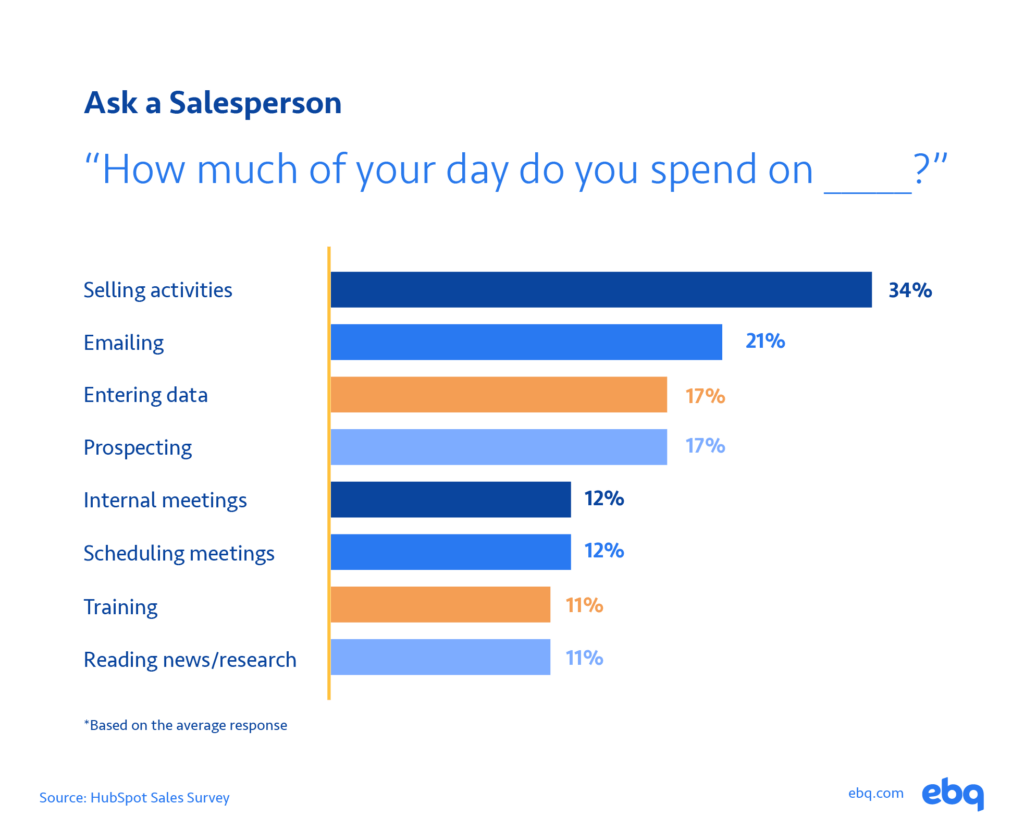Connect with a Consultant
Fill out your information with the form provided and one of our team members will reach out to you shortly.

This post was originally published in July 2022 and has been updated for accuracy and comprehensiveness.
According to a recent HubSpot report, the average B2B buyer committee has five people in every sale. This means that your sales team must navigate various hurdles to close a deal. So what are the most common sales challenges and how would you overcome them?
In our 16+ years of experience, we can tell you that the 7 biggest B2B sales challenges are:
But first, let’s start by discussing the biggest differences between B2B and B2C sales.

Learn what it takes to identify prospects, get in touch with decision-makers, and set more meetings for your sales reps.
While B2B and B2C sales require persistence and a full understanding of your buyer persona, they also present their unique differences.


Your users are often experts within their respective fields, so you must be more tactical when handling B2B sales challenges. Next, we’ll share how we’ve overcome the B2B industry’s biggest sales challenges.
As many business leaders can tell you, hiring and retaining a sales team can be difficult. Studies show that a new sales rep will reach full productivity after 15 months of being in their roles. However, the average sales rep will leave after 18 months — leaving only 3 months of full productivity per salesperson before they decide to leave.
Gallup estimates that replacing a worker can cost you 0.5x-2x their annual salary, so your best bet is to find creative ways to find and retain eager team members.
Your goal here is to make sure your business scales as your sales team grows. You can do this by creating opportunities to optimize your ROI while looking to hire top talent.
In 2023, more than 50% of companies experienced an even longer sales cycle than they did previously. That’s because more than 80% of deals won takes more than five follow-up touches to convert a prospect.
Take a look at Cap Patrol as an example. The company needed to meet with golf professionals at clubs who have the purchasing power to invest in their solution.
These are busy people that are making these decisions, so we needed to be professional yet persistent in the approach.
George Thurner CEO of Cap Patrol
To accelerate your sales cycle, you need to target the right stakeholders and send the right sales message from the get-go.
Circling back to Cap Patrol, they were able to leverage both EBQ’s data and appointment-setting services to find the right prospects to nurture. As a result, they were able to win more than $50,000 in deals and set more than 100 appointments.
Did you know that only 30% of sales professionals think their sales and marketing teams are closely aligned? Misalignment can cause a flurry of consequences, such as leaving a disorganized first impression on prospects and lowering team morale.
As a quick recap of the post we wrote about aligning your sales and marketing teams, you should:
By strengthening the partnership between your sales and marketing teams, you will have a more organized lead qualification process — which empowers your sales team to better prioritize the warmest leads.


A strong brand authority promotes a higher level of trust between yourself, your customers, and your prospects. However, most industries are saturated with steep competition; finding creative ways to stand out can be tough.
We found that a well-thought-out marketing branding strategy lends itself well to establishing a credible reputation. Think about it: would you trust a company that does not have an intuitive website, has spelling mistakes all over its content, and uses spammy clickbait tactics to get your attention?
However, even the most experienced marketing professionals can not do all marketing tasks well. That’s why we recommend taking the time to build a multi-faceted marketing team that consists of:
By strengthening the partnership between your sales and marketing teams, you will have a more organized lead qualification process — which empowers your sales team to better prioritize the warmest leads.
As we previously discussed, salespeople sell their products for an average of two hours a day. From internal meetings to administrative tasks, no wonder salespeople do not spend a lot of their time forming relationships with their customers.

To help your salespeople maximize their day, you need to standardize best practices and use automation to bypass manual administrative tasks. With the rise of AI, you still need to be wary of over-automating your sales processes. After all, humans respond best to sales messages that have a human touch.
Read more: Do you know how bad data can lead to exponential negative consequences? In fact, bad B2B data can waste more than 25% of a sales rep’s time. Read “Risks of Poor Sales Data Quality and How to Improve Your Data” to learn how to prevent bad data from permeating your database.
While there are more people within the buyer committee, finding people with purchasing power can be like finding a needle in a haystack. Identifying them is just the beginning, as you’ll need to get past gatekeepers and jump through various hurdles to get to them.
For a more in-depth guide on how to find decision-makers, check out Chapter 2 of our Ultimate Guide to Appointment Setting. To summarize, you’ll want to:

Learn what it takes to identify prospects, get in touch with decision-makers, and set more meetings for your sales reps.
Most B2B buyers say “no” four times before saying yes, but studies have shown that 48% of salespeople usually give up on the prospect after the first “no.”
From our experience, budget is often the most common roadblock that prevents a prospect from converting. This means that while the prospect sees the value of a solution, they are preemptively trying to figure out if the ROI is worth the investment.
We have a common saying in the B2B sales world: Buyers are liars. By digging deeper into the conversation, your salespeople can unravel the true reason why a decision-maker is hesitant to invest. You can prepare these people by:
Read more: Over the years, our sales leaders have learned how to effectively respond to common objections, such as “it’s too expensive” and “I’m busy right now.” Find out how to address prospect hesitation with our blog post “Cold Calling Objections and Responses for B2B Appointment Setting.”
By addressing these common challenges with strategic solutions, B2B sales teams can enhance their effectiveness, close more deals, and drive sustained business growth. The key to staying competitive in B2B sales is continuous learning and adaptation.
These are the seven biggest challenges we’ve seen B2B sales leaders face:
We’ve mentioned this a few times throughout the post, but outsourcing your SDR team is a great way to push costs low while maintaining high productivity. Contact our Business Consultants to learn why thousands of businesses choose to partner with us.
Fill out your information with the form provided and one of our team members will reach out to you shortly.
6800 Burleson Road
Building 310, Suite 265
Austin, TX 78744
©EBQ 2023 All rights reserved.
Tell us about yourself and we’ll get in touch shortly.
